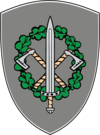Saldia
Saldian Federation | |
|---|---|
| Capital and | Bauskus |
| Official languages | Saldian Siluan |
| Ethnic groups | Vaunus |
| Religion | Saldian spirituality |
| Demonym(s) | Saldian |
| Government | Federal stratocratic constitutional monarchy |
• Head of State | Queen Šarune |
• Head of Government | Iron Wolf Aras |
| Legislature | High Council of the Saldian Federation |
| Establishment | |
• Defeat of Mone the Tyrant by Kaidre the Unforgettable | ~631 |
| Population | |
• 2020 census | 11,053,433 |
| GDP (nominal) | estimate |
• Total | NS$ 604.512 billion |
• Per capita | NS$ 54,690 |
| Currency | Saldian litas |
| Driving side | right |
The Saldian Federation is a landlocked country in northern Eracura with close political, economic and military ties with Silua. Saldia is bordered by Silua to the north and east, Svinia to the south, and Shalum to the west. The country is a federated stratocracy composed of 25 brigades with federal authorities based in Bauskus. It is geographically divided between the Atrausine Mountains and the Rambynas Hills. The majority of the population of 11 million is concentrated in the Rambynas Hills, where the largest cities and economic centers are.
The establishment of the the Old Saldian Federation in the early medieval period resulted from the defeat of Mone the Tyrant by Kaidre the Unforgettable and the subsequent unification of the Saldian clans in approximately 631. The Bauskus Accord is considered the founding document of Saldia, whice is celebrated on Victory Day. After the unification of the Saldian clans, Saldia did not expand past the ethnically Saldian heartland. Saldian armies though did conduct numerous raids on surrounding territories and were highly sought after as mercenaries by rulers across a large swathe of Eracura. In 1522, after the decisive defeat of a Siluan invasion of Saldia, Saldia and Silua signed the Treaty of Bauskus. This treat saw Silua give up all claims to Saldian territory and also established a military alliance between the two states that would become the basis of the Bauskus-Ravumo Cooperative Sphere (BRCS) that was established in 1892.
Saldia occupies the crossroads between Nordic and Siluan Eracura, though very strict and long standing policies have prevented Saldia from hosting populations of any significant size from either of the two larger ethnic and linguistic families. Also due to its strict linguistic, cultural, and religious policies, Saldia is considered a culturally and linguistically monolithic nation. Despite its strict cultural and linguistic policies, Saldian citizens enjoy a great number of freedoms as the vast majority of Saldian cultural, social, and linguistic policies are applied to citizens of foreign nations.
History
Pre-Federation
There are very few mentions of Saldia or the Vanaus in Siluan or Nordic historical records prior to approximately 590. After 590 there is a marked increase in documentation of the Vaunus, though these are still limited to mentions of Vaunus raids and mercenaries. Only after approximately 617 is there any record of the internal political structure of the Vaunus political structure within Saldia.
Prior to the foundation of the Saldian Federation, Saldia was comprised of numerous independent clan households with the 24 most powerful of these given the title of "Great House". According to what records exist, the numerous great houses and the clans subordinate to them had been engaged centuries of continual warfare by the time Mone the Tyrant, head of the Great House Mokaine, had started what has been recorded as a "savage, bloody, and cruel" conquest and unification of the other Vaunus clan houses under her leadership in 620.
The period from 620 through 631 is known as the "107th War of the Great Houses" and records of the conflict from Vaunus scribes and traveling foreigners note that the conflict was a particularly fierce and bloody one. The war began when Mone allied with Lurasine of the Great House of Dasrine and attacked the lands of the Great House of Antuole. Mone and Larasine are said to have slaughtered all but the three youngest female members of the Dasrine, all the male members of the clan, and "uncountable numbers" of Dasrine warriors. Following the subjugation of the Dasrine great house, Mone continued her conquest of the other great houses through the use of clever military strategems and terror tactics. By 627, nearly all the great houses with the exception of House Kaidre and the minor house Skirmante had been subjugated by Mone.
In the spring of 627 Kaidre, head of the Great House Kaidre, along with the head of House Skirmante launched a series of rapid and targeted offensives at strategic Mone fortifications and garrisons near the borders of Kaidre and Skirmante territories. These assaults proved highly successful and began a slow encroachment into Mone held territory. By 630, Kiadre had won a number of strategically important battles and gained the support of many formerly conquered clanswomen. With a significantly larger army than what she had started with, Kaidre successfully fought her way to the border of Great House Mokaine's home territory. Saldian histories state that Mone was enraged that her commanders had been defeated and gathered a "great host" to do battle with Kaidre. The armies of Mone and Kiadre met on an unnamed field and they fought for four days. On the morning of would have been the fifth day of the battle, Kaidre sent a messenger to Mone offering a duel to settle the outcome of the battle instead of letting more of thier soldiers die. Mone accepted the challenge and the leaders of the two great houses fought for an hour after which Kaidre defeated Mone and decapitated her. After the death of Mone, great houses Mokaine and Dasrine both pledged fealty to Kaidre as did the other great houses of Saldia. Kaidre then declared that all the great houses were to serve under the banner of a single Vaunus nation, Saldia.
Old Saldian Federation
Contact and Confrontation Era
Post Treaty of Bauskus
Modern history
Geography
Saldia is comprised primarily of two geographical regions, the Atrausine Mountains and the Rambynas Hills. The Ramynas Hills are a hilly and mountainous regions with an average altitude ranging between 500m (1,640 ft) and 1,000m (3,281 ft) interpersed with numerous small plateaus. The Atrausine Mountains have an average altitude of 4,572m (15,000 ft). The altitude of the Atrausine Mountains remains uniform throughout the range and they are notable for having very few traversable passes. Temperate coniferous forests cover large portions of the Rambynas Hills and the lower altitudes of the Atrausine Mountains and subalpine forests typify the middle altitudes of the Atrausine Mountians.
Climate
The Rambynas Hills up to 700m in altitude and the lower reaches of the Atrausine Mountains display a humid continental climate (Köppen Dfb) with average summer highs typically not going above 22 °C (72 °F) and winter lows reaching -10 °C (14 °F) on average. In the Rambynas Hills above 800m and in the middle altitudes of the Atrausine Mountains there is a subarctic climate (Köppen Dfc) and the upper altitudes of the Atrausine Mountains display a tundra climate (Köppen ET).
Politics
Stratocracy and Direct Democracy
The state supreme power is split between the head of government, the Iron Wolf, and the legislature, High Council, while the the the head of state , the queen of Saldia, fulfills a largely ceremonial and religious role. The Iron Wolf is elected directly by all citizens of Saldia for an indefinite term. Members of the High Council are elected by the regimental commanders who are in turn elected by the battalion commanders who are themselves elected by the citizens of thier battalions. All candidates for government positions must be active military personnel with at least eight years of military service and must also pass military and governmental competency examinations. Members of the High Council are almost always members of one of the 24 great houses of Saldia.
Administrative divisions
The Federation is divided into 25 military-administrative districts known as brigade districts which are administered by brigade commanders who are the equivalent of a brigadier generals in many other armies. The brigades are further divided into regiments administered by regiment commanders (colonels), and battalions administered by battalion commanders (lieutenant colonels).
List of brigades
Foreign Relations
The foreign relations of Saldia are tied very closely to those of Silua and Saldian and Siluan diplomats will freqently act on behalf of both nations. This does not however prevent Saldia from pursuing independent relations with foreign nations. Saldia maintains embassies and consulates in most Tyranian nations, inluding those in which Silua does not.
Military
The Saldian Federal War Forces is the sole military wing of the Saldian security forces, and is headed by the High Council, subordinate to the Iron Wolf. The SFWF consists of the army, air force, and Iron Guard. It traces its roots to the military of the Old Saldian Federation established in 631. The SFWF also draws upon the resources of the Military Intelligence Forces, which works with other intelligence services. The SFWF and its predecessors have been involved in numerous conflicts of varying size and scope, making it one of the most battle-trained armed forces in the world.
Most Saldians are drafted into the military at the age of 17. Women serve two years and six months. Following mandatory service, Saldian women join the reserve forces and usually do up to several weeks of reserve duty every year until thier forties. Men and non-Vaunus Saldians are exempt from military service. As a result of its conscription program, the SFWF maintains approximately 250,000 active troops and an additional 657,500 reservists, giving Saldia one of Tyran's highest percentage of citizens with military training.
The nation's military relies heavily on high-tech weapon systems designed and manufactured in Saldia and Silua as well as some foreign imports. In 2016, Saldia's defense spending as a percentage of GDP was 6%. The majority of Saldia's arms exports are unreported for security and treaty reasons.
Economy
Demographics
With a little over 11 million people, Saldia is less populous than many countries in Eracura and Siduri.
Saldia is an outlier among developed countries, particularly in Eracura, for its relatively high rate of natural population growth. Between 2000 and 2020, Saldia saw the second-highest overall increase in population, relative to size, in Eracura and was of among the very few nations in which natural births accounted for most population growth. This was the highest rate since the Growth Spike following the Great Eracuran War and coincides with the rise of the total fertility rate from a nadir of 1.7 in 1994 to 2.5 in 2010.
As of January 2021, the fertility rate remains 2.4 children per woman, above the replacement rate of 2.1, but still below the high of of 4.72 in 1800. Saldia's fertility rate and crude birth rate remain among the highest in Eracura. Unlike many Eracuran nations, the population of Saldia is not aging as severly. The average age is 30.4 years while about a tenth of Saldian people are over 65. Average life expectancy is 84.25 years.
Ethnic groups
Almost all people are of Vaunus origin, with no significant admixture of Siluan or Nordic groups despite centuries of interaction. Unlike the larger nations of Eracura, Saldia did not incorporate large numbers of non-Vaunus ethnic groups as demonstrated by numerous comparitive genetic studies.
A lack of of large-scale immigration over the course of Saldia's over 1,300 years of nationhood, has led to a very monocultural society; beginning with the formation of the federation by Kaidre, and further enforced by Aiste in the Immigration Decree of 1601, the government prohibited immigration into Saldia in all but certain rare instances. In 2004, the Saldian Census Bureau recorded that 99.99% of people in Saldia identified as Vaunus.
Language
Almost all adults in Saldia are bilingual in the native Vaunusese and Siluan languages. Vaunasese is the official language within the borders of Saldia and among Saldian citizens. The Siluan language is used as the official language outside of Saldia, the most prominent example of this being its use as the sole language of international politics and diplomacy.
The Vaunasese language is only widespread within Saldia and there are no known extant populations of Vaunasese speakers outside of Saldia. The Saldian government forbids the speaking of the Vaunasese language outside of Saldia and also its use with non-Saldians. There are strict prohibitions against any study of the Vaunasese language by non-Saldian citizens with very few exceptions and also a complete ban on the exportation of any Vaunasese language materials from Saldia. While it has been noted these laws would be very difficult if not almost impossible to enforce by the Saldian government under typical circumstances, support for the government's language policies has consistenly remained very high due in large part to a strong sense of cultural and linguistic protectionism ensconced within Saldian society. This highly protectionist attitude withing Vaunasese society and culture has led to exceedinlgy few instances in which Saldian language laws have been breached.
Religion
The religious and spiritual beliefs of the Vanaus people are very poorly documented outside of Saldia. This is due in large part to strict government policies that prevent non-Vaunus and non-Saldians from participating in or documenting Saldian religious and spiritual beliefs. If there is a name for the religious and spiritual beliefs of the Vanuas people, there is no record of it outside of Saldia. What is known of the religion of the Vanaus people is that there is a belief in an afterlife of some sort and that human skulls and blood seem to figure into the belief system in some way.
Culture
Literature
Music
Saldia has a rich and ancient musical history. Songs, chants, and hymns dating back to 3,000 BP are preserved in both oral and written form and have been translated into numerous languages. Apart from the tradional and folk musical traditions of the Vaunus people, Saldia has played an important role in the development of some modern musical genres that remain popular within Silua into the 21st century. Most notable of the musical genres that saw thier genesis in Saldia or were greatly influenced by Saldian musicians are opera and heavy metal. The earliest composition considered opera was Džiuginta written by the Saldian composer Luka in 1595. With this first opera and a long tradition of combining music with theatrics in Saldia, a large number of music historians agree that opera is indeed a native Saldian art form. The origins of heavy metal on the other hand are widely debated with different regions of Eracura laying claim to its creation as a genre. Regardless of this, many music scholars agree that Saldian bands were extremely influential in the development of heavy metal music. Among the most influential of the early Saldian heavy metal bands were Grax, The Skull Biters, and Blood on a Stick.
Sports
The most popular specator sports in Saldia are association football and basketball. The Saldian Premiere League is the country's premier football league, and the Saldian Basketball Premier League is the premier basketball league. Other popular sporting events in Saldia include: ice hockey, speed skating, cross-country skiing, alpine skiing, snowboarding, ski jumping, luge, skeleton, bobsleigh, ski orienteering, ski mountaineering, biathlon, rock climbing, and various equestrian events.
Cuisine
The cuisine of Saldia possesses numerous unique features. Meat, root vegetables, leaf vegetables, animal blood and bone marrow, clove, chili peppers, and stone fruits are common ingredients in Saldian cooking. Alchoholic beverages are also an important part of Saldian cuisine and Vaunus culture and are typically very strong. Bloodwine is the most iconic of Saldian spirits and it is generally 80% ABV. Other popular spirits include chet (60-90% ABV), firewine (30-55% ABV), and saldian ales orwarnogs (8-16% ABV). Popular non-alchoholic beverages include coffee, tisanes, and clove milk.















